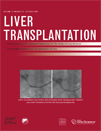Reply: Distinguishing between hepatic portal vein gas and pneumo(aero)bilia
We thank Yarze and Markowitz for the opportunity to correct an important detail concerning our image of a patient with hepatic gas gangrene following liver transplantation.1 They are absolutely right in pointing out that the peripheral branching gas lucencies represent in fact portal vein gas. On computed tomography scans, portal vein gas is characterized by linear branching gas collections close to the hepatic capsule, whereas gas in the biliary tract (pneumobilia) tends to move with the centripetal flow of bile toward the hilum.2 As Yarze and Markowitz mention, portal vein gas can be quickly detected by its typical pattern of distribution. This might enable early recognition of bowel mucosa injury and/or bowel mucosa invasion by gas-producing bacteria, such as Clostridium perfringens.
REFERENCES
Johannes Hadem*, * Gastroenterology, Hepatology, and Endocrinology, Hannover Medical School, Hannover, Germany.




